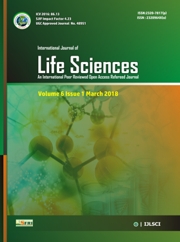Research Article
Volume 8 |Issue 6| November-December 2020 First published: 10 December 2020
Effect of mycorrhizal inoculation on growth and establishment of micropropagated Leucaena leucocephala (Lam.)de Wit
Naqvi Nikhat
Botany Department, SFS College, Seminary Hills, Nagpur, MS, India
Email: naqvin@rediffmail.com
Abstract
Keywords:Leucaena leucocephala ,Arbuscular mycorrhiza, micropropagation.
Editor: Dr.Arvind Chavhan
Cite this article as:
Naqvi Nikhat. Effect of mycorrhizal inoculation on growth and establishment of micropropagated Leucaena leucocephala (Lam.)de Wit, Int. Res. Journal of Science & Engineering, 2020, Volume 8(6): 212-218.
Copyright:
Open Access This article is licensed under a Creative Commons Attribution 4.0 International License, which permits use, sharing, adaptation, distribution and reproduction in any medium or format, as long as you give appropriate credit to the original author(s) and the source, provide a link to the Creative Commons license, and indicate if changes were made. The images or other third party material in this article are included in the article’s Creative Commons license, unless indicated otherwise in a credit line to the material. If material is not included in the article’s Creative Commons license and your intended use is not permitted by statutory regulation or exceeds the permitted use, you will need to obtain permission directly from the copyright holder. To view a copy of this license, visit http://creativecommons.org/ licenses/by/4.0/
References
1. Idol T, Youkhana A, Santiago RP. Vegetative and micropropagation of Leucaena. Tropical Grasslands 2019, 7(2):87-95.
2. Dhawan V, Bhojwani SS. Hardening in vitro and morphophysiological changes in the leaves during acclimatization of micropropagated plants of Leucaena leucocephala (Lam.) de Wit. Plant Science, 1987, 53:65-72.
3. Hooker JE, Gianinazzi S, Vestberg M, Barea JM, Atkinson D. The applications of arbuscular mycorrhizal fungi to micropropagation systems: an opportunity to reduce inputs. Agric. Sci. Finland, 1994, 3:227-232.
4. Monticelli S, Puppi G, Damiano C. Effects of in vivo mycorrhization on micropropagated fruit tree rootstocks. Applied Soil Ecology, 2000, 15:105-111.
5. Estrada-Luna AA, Davies FT Jr., Egilla JN. Mycorrhizal fungi enhancement of growth and gas exchange of micropropagated guava plantlets (Psidium guajava L.) during ex vitro acclimatization and plant establishment. Mycorrhiza, 2000, 10:1-8.
6. El Kinany S, Achbani E, Faggroud M, Ouahmane L, El Hilali R, Haggoud A, Bouamri R. Effect of organic fertilizer and commercial arbuscular mycorrhizal fungion the growth of micropropagated date palm cv. Feggouss. Journal of the Saudi Society of Agricultural Sciences, 2019, 18:411-417.
7. Rapparini F, Baraldi R, Bertazza G, Branzanti B, Predieri S. Vesicular arbuscular mycorrhizal inoculation of micropropagated fruit trees. J. Hort. Sci., 1994, 69:1101-1109.
8. Qiang-Sheng W, Ying-Ning Z, Gui-Yuan W. Arbuscular Mycorrhizal Fungi and acclimatization of Micropropagated Citrus, Communications in Soil Science and Plant Analysis, 2011, 42(15): 1825-1832.
9. Schellenbaum L, Berta G, Ravolanirina F, Tisserant B, Gianinazzi S, Fitter AH. Influence of endomycorrhizal infection on root morphology in a micropropagated woody plant species (Vitis vinifera L.), Ann Bot, 1991, 68 : 135-141.
10. Vidal MT, Azcón-Aguilar C, Barea JM, Pliego-Alfaro F. Mycorrhizal inoculation enhances growth and development of micropropagated plants of avocado, Hort Science, 1992, 27 : 785-787.
11. Azcón-Aguilar C, Cantos M, Troncoso A, Barea JM. Beneficial effect of arbuscular mycorrhizas on acclimatization of micropropagated cassava plantlets, Sci. Hort., 1997, 72:63-71.
12. Smith SE, Read DJ. Mycorrhizal symbiosis, 3rd ed. San Diego, Calif., Academic Press, 2008.
13. Schüßler A, Walker C. The Glomeromycota: a species list with new families and new genera. The Royal Botanic Garden Edinburgh, The Royal Botanic Garden Kew, Botanische, 2010.
14. Marschner H, Dell B. Nutrient uptake in mycorrhizal symbiosis, Plant and Soil, 1994, 159:89–102.
15. Naqvi N, Naqvi SAMH. Mycorrhiza in management of Fruits and Vegetable diseases In: Diseases of Fruits and Vegetables - Diagnosis and Management, S.A.M.H Naqvi (Ed), Vol II, Kluwer Academic Publishers, Netherlands. 2004, pp 537-558.
16. Gamborg OL, Miller RA, Ojima K. Nutrient requirements of suspension cultures of soybean root cells, Experimental Cell Research, 1968, 50:151-158.
17. Phillips JM, Hayman DS. Improved procedures for clearing roots and staining parasitic and vesicular- arbuscular mycorrhizal fungi for rapid assessment of infection, Trans. Br. Mycol. Soc., 1970, 55: 158-161.
18. Wang H, Parent S, Gosselin A and Desjardins Y. Vesicular-arbuscular mycorrhizal peat-based substrates enhance symbiosis establishment and growth of three micropropagated species,J. Am. Soc. Hortic. Sci., 2019, 118: 896 – 901.
19. Singh NV, Singh SK, Singh AK, Meshram DT, Suroshe SS, Mishra DC. Arbuscular mycorrhizal fungi (AMF) induced hardening of micropropagated pomegranate (Punica granatum L.) plantlets, Sci. Hortic., 2012, 1: 122 – 127.
20. Smith SE and Smith FA. Fresh perspectives on the roles of arbuscular mycorrhizal fungi in plant nutrition and growth, Mycologia, 2012, 104 :1 – 13
21. HareKrishna, Singh SK, Sharma RR, Khawale RN, Grover M, Patel VB. Biochemical changes in micropropagated grape (Vitis vinifera L.) plantlets due to arbuscular-mycorrhizal fungi (AMF) inoculation during ex vitro acclimatization, Scientia Horticulturae, 2005, 106(4):554-567.
22. Thiagarajan TR, Ahmad MH. Phosphatase activity and cytokinin content in cowpea (Vigna unguiculata) inoculated with a vesicular-arbuscular fungus, Biology and fertility of soils, 1994, 17:51-56.
23. Allens MF, Moore TS, Christensen JR Christensen M. Phytohormone changes in Bouteloua gracilis infected by vesicular-arbuscular mycorrhizae. I.Cytokinin increases in the host plant, Canadian Journal of Botany, 1980, 58:371-374.
24. Yano-Melo AM, Junior OJS, Lima-Filho JM, Melo NF, Maia LC. Effect of arbuscular mycorrhizal fungi on the acclimatization of micropropagated banana plantlets, Mycorrhiza, 1999, 9:119–123.
25. Srivastava V, Singh AK. Mycorrhization alters root morphology, leaf starch and nutrient content of micropropagated banana under water stress, Indian Journal of Horticulture, 2019, 76(1):44-49.
26. Lovato PE, Trouvelot A, Gianinazzi-Pearson V, Gianinazzi S. Enhanced growth of wild cherry using micropropagated plants and mycorrhizal inoculation, Agronomy for Sustainable Development, 2006, 26:209–213.

